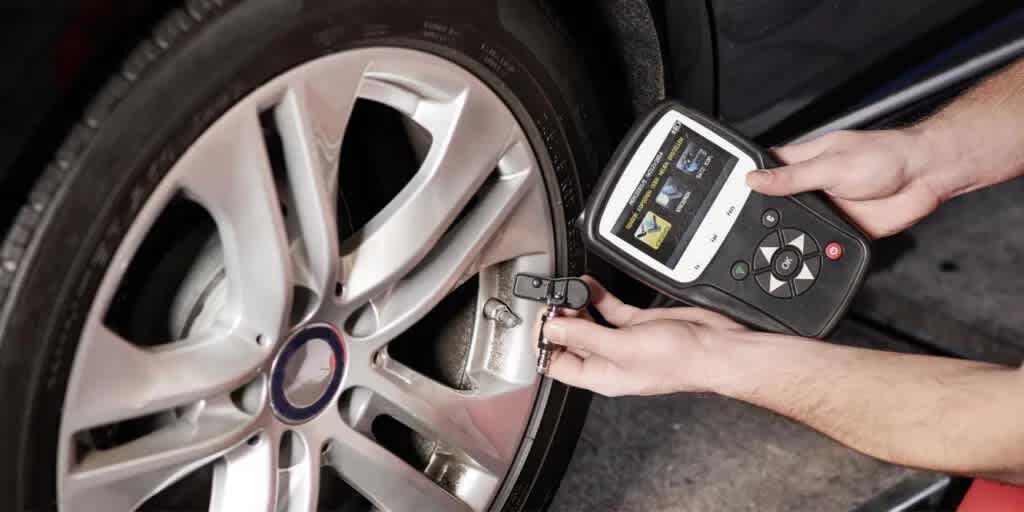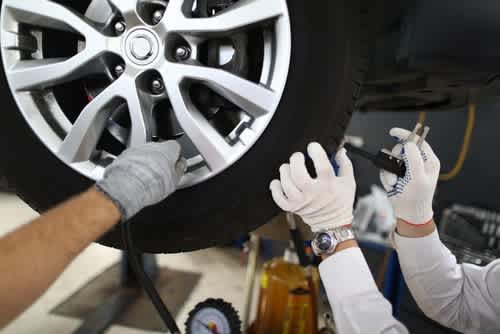Tire Maintenance Safety
Best price guarantee
Tire replacement coverage
24/7 roadside assistance
Easy returns

Maintaining proper tire pressure is essential for ensuring a safe and efficient driving experience. Tire Pressure Monitoring Systems (TPMS) have revolutionized the way drivers keep their tires properly inflated, providing real-time information and alerts when tire pressure falls below recommended levels.
TPMS sensors are the unsung heroes of modern vehicle safety, working tirelessly to monitor tire pressure and keep drivers informed. These small but mighty devices have become an integral part of today's automobiles, offering numerous benefits that extend beyond just convenience.
In this article, we'll dive deep into the world of TPMS sensors, exploring their functionality, advantages, and the crucial role they play in maintaining optimal tire performance. Whether you're a seasoned driver or a new vehicle owner, understanding TPMS sensors is key to ensuring a smoother, safer, and more efficient ride.
What is a TPMS Sensor?
TPMS stands for Tire Pressure Monitoring System—an electronic system designed to monitor the air pressure inside a vehicle's tires. This innovative technology provides real-time tire pressure information to the driver via a dashboard display or warning light, ensuring that tires remain properly inflated for optimal safety, fuel efficiency, and longevity.
TPMS sensors are small, battery-powered devices mounted inside each tire that continuously measure the air pressure within. These sensors transmit data wirelessly to a vehicle's onboard computer, which then interprets the information and alerts the driver if any tire pressure falls below a predetermined threshold.
The importance of TPMS sensors cannot be overstated: they serve as a vital early warning system, helping prevent accidents, blowouts, and premature tire wear caused by underinflated tires. By maintaining proper tire pressure, TPMS sensors also contribute to better fuel economy and reduced emissions, making them an essential component of modern vehicle safety and efficiency.
How Do TPMS Sensors Work?
TPMS sensors operate using two primary systems: Direct and Indirect. Each system has distinct methods for monitoring tire pressure, yet both aim to ensure optimal tire performance and safety.
Direct TPMS
Direct TPMS integrates sensors within each tire that continuously gauge the air pressure. These sensors communicate wirelessly with a vehicle's control unit, offering immediate updates on tire conditions. This system excels in its ability to detect underinflation with high accuracy, providing timely alerts to drivers. This responsiveness plays a crucial role in maintaining safety and vehicle performance. Direct TPMS stands out for its detailed and reliable data, making it ideal for those who value precision.
Indirect TPMS
Indirect TPMS functions differently by utilizing the vehicle's existing systems to monitor tire conditions. It measures the rotational speed of each wheel through the ABS sensors, deducing tire pressure variances from speed changes. When a tire's rotation rate is inconsistent with the others, it signals a potential pressure issue, prompting a warning to the driver. This approach leverages existing vehicle components, offering a more economical option. While it efficiently indicates pressure discrepancies, its indirect method may not provide the same level of detail as direct systems.
Benefits of TPMS Sensors
TPMS sensors contribute significantly to vehicle safety and operational efficiency. Their primary function is to notify drivers of underinflated tires, effectively minimizing the chances of accidents that can result from decreased tire performance. This timely information allows drivers to address tire pressure issues promptly, ensuring a safer journey for everyone on the road.
In addition to enhancing safety, TPMS sensors are instrumental in promoting energy efficiency. Proper tire inflation minimizes rolling resistance, thereby optimizing fuel consumption. This leads to cost savings on fuel and extends the lifespan of tires by promoting even wear, which reduces the need for frequent replacements.
The environmental impact of TPMS sensors is also noteworthy. By improving fuel efficiency and extending the life of tires, these systems contribute to lower emissions and a reduction in tire waste. Vehicles that maintain correct tire pressure consume less fuel, resulting in fewer emissions, and the extended tire life means less environmental waste, aligning with sustainability efforts.
Moreover, the consistent monitoring provided by TPMS sensors offers a sense of security for drivers. With continuous updates on tire conditions, drivers can remain focused on their journey without the worry of unexpected tire issues, enhancing overall driving confidence.
Maintaining Your TPMS Sensors

Proper upkeep of your Tire Pressure Monitoring System is essential for its reliability. While the system provides real-time updates, conducting manual checks ensures that the sensors are accurately reflecting the tire conditions. Keeping a dependable tire gauge in your vehicle assists with these checks, confirming that tire pressure remains at optimal levels and that the TPMS is effectively alerting you to any issues.
The longevity of TPMS sensors hinges on their battery life, with most sensors operating efficiently for up to a decade. As the batteries approach the end of their lifespan, timely replacement becomes crucial to maintain uninterrupted monitoring. Regularly consulting the vehicle's maintenance log helps track when sensor replacements are due, ensuring the continued efficacy of the system.
Routine vehicle servicing is vital for maintaining the precision of TPMS readings. Regular tire rotations, alignments, and balancing not only promote even tire wear but also enhance the system's accuracy. Adhering to the vehicle's owner's manual for maintenance schedules provides specific guidance tailored to your vehicle, supporting the overall performance and reliability of your TPMS.
What to Do When the TPMS Light Comes On
When the TPMS light activates on your dashboard, immediate attention is necessary. First, find a secure spot to stop and examine your tires. Look for any apparent signs of issues, such as a tire that appears significantly deflated or objects embedded in the tread.
Once you've visually inspected the tires, use a tire pressure gauge to measure each tire's pressure. Compare these measurements against the manufacturer's recommended levels, typically found on the tire placard located on the driver’s side door jamb or in the vehicle's owner manual. Ensuring each tire is inflated to the appropriate level is critical for maintaining vehicle safety and performance. Should any tire exhibit low pressure, adjust it to the specified level right away.
If the TPMS warning remains illuminated after correcting the tire pressure, this might indicate a deeper problem that requires expert evaluation. Persistent alerts can suggest a malfunction within the TPMS sensors, such as battery depletion or sensor issues. In such situations, seeking advice from a professional technician is recommended. While TPMS is a reliable system for keeping track of tire health, complementing it with regular manual inspections ensures comprehensive tire maintenance and safety.
The Importance of Proper Tire Pressure

Tire pressure plays a pivotal role in vehicle dynamics, affecting everything from fuel consumption to the overall driving experience. When tires lack sufficient air, they create more friction with the road, which forces the engine to exert additional effort, leading to higher fuel usage. This excessive drag not only decreases fuel efficiency but also accelerates tread wear, especially along the edges, shortening the tire's service life.
On the other hand, having too much air in the tires can bring its own set of challenges. Overinflated tires tend to transmit more road imperfections to the vehicle, resulting in a less comfortable ride. This condition can cause the center of the tread to wear faster and increase the risk of damage from sharp objects or potholes. Moreover, reduced contact with the road surface can impair traction, particularly in adverse weather conditions.
Temperature changes can lead to fluctuations in tire pressure, as air expands and contracts with varying temperatures. This natural process makes regular pressure checks essential to ensure tires remain at optimal levels. To maintain the correct pressure, it's vital to consult the tire pressure recommendations found on your vehicle’s tire placard or in the owner’s manual. Embracing the utility of TPMS sensors helps maintain ideal tire pressure, enhancing vehicle safety and prolonging tire life.
As we've explored, TPMS sensors are a vital component of modern vehicle safety and efficiency, providing real-time monitoring and alerts to help you maintain optimal tire pressure. By understanding how these systems work and the benefits they offer, you can make informed decisions about your vehicle's maintenance and enjoy a safer, smoother, and more efficient driving experience. At SimpleTire, we're committed to making tire shopping easy and affordable, so when it's time for new tires, shop for tires online with SimpleTire and find the best deals to keep your vehicle running at its best.
With older indirect TPMS systems, the sensor can’t differentiate between tires and will just light up the dashboard indicator to let the driver know that one is low on air. Direct TPMS systems use a more sophisticated set of signals and an upgraded processor to track the pressure of each individual tire.
Yes, reset or replacement of TPMS sensors should be part of replacing tires. As your old tires wear down, their diameter changes due to a thinner layer of rubber at the tread, which changes their rotational speed. New tires will require a reset of the sensors to accommodate this difference.
Ready to find the perfect tires?
Search By